-
Car Reviews
- Car News
-
Car Comparisons
Latest comparisons
- Chasing Deals
Ford’s smaller, unibody ute brings the right amount of practicality, capability and fun
The American pickup scene has lost its way over the past few decades in a never-ending pursuit of bigger is better.
Thankfully, that’s starting to change, and the Maverick is the latest sign of Ford doing more with less.
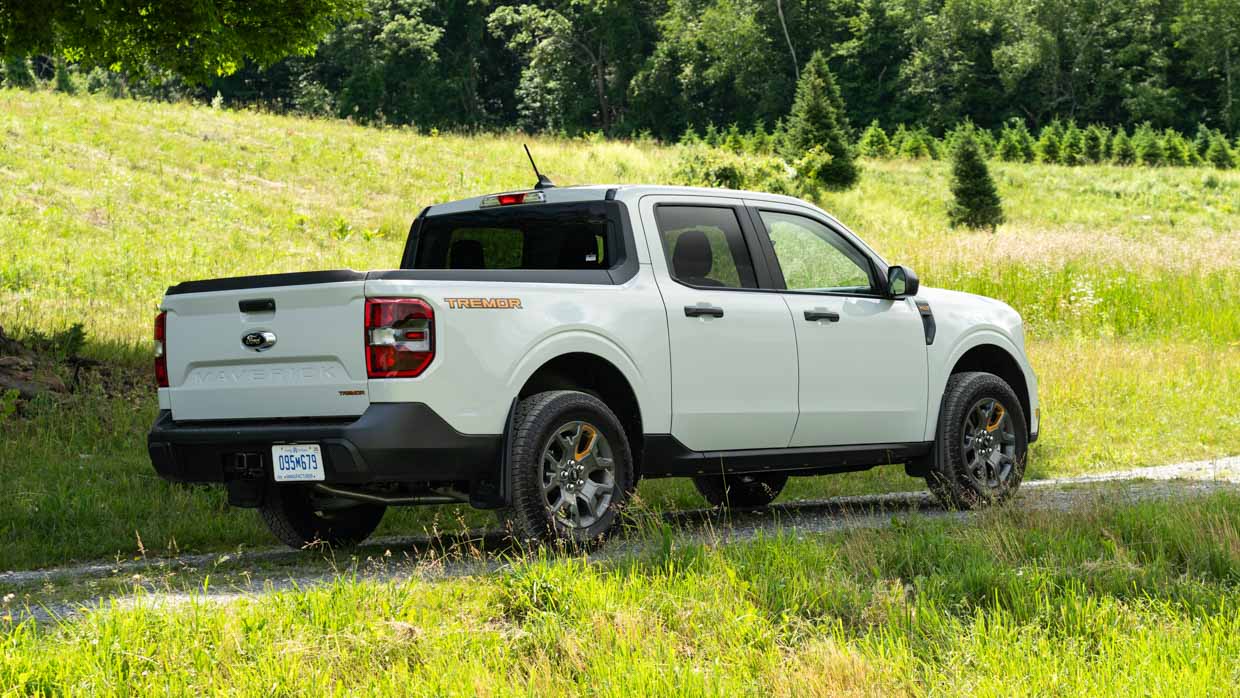
Though some Ranger and F-150 aficionados will debate whether the Maverick really is a ‘truck’, with its car-like unibody construction and all-wheel-drive instead of 4×4 drivetrain, the rest of the world can simply get on with appreciating Ford’s ute that is, for most, the perfect mix of practicality and capability.
Add in the Tremor package, and you have a good bit of fun, too.
Despite sitting on the same C2 platform as the Escape midsize SUV, which is set to depart from Australia later this year, Ford Australia’s official line is that the Maverick is not currently under consideration for our market due to its lack of availability in right-hand drive.
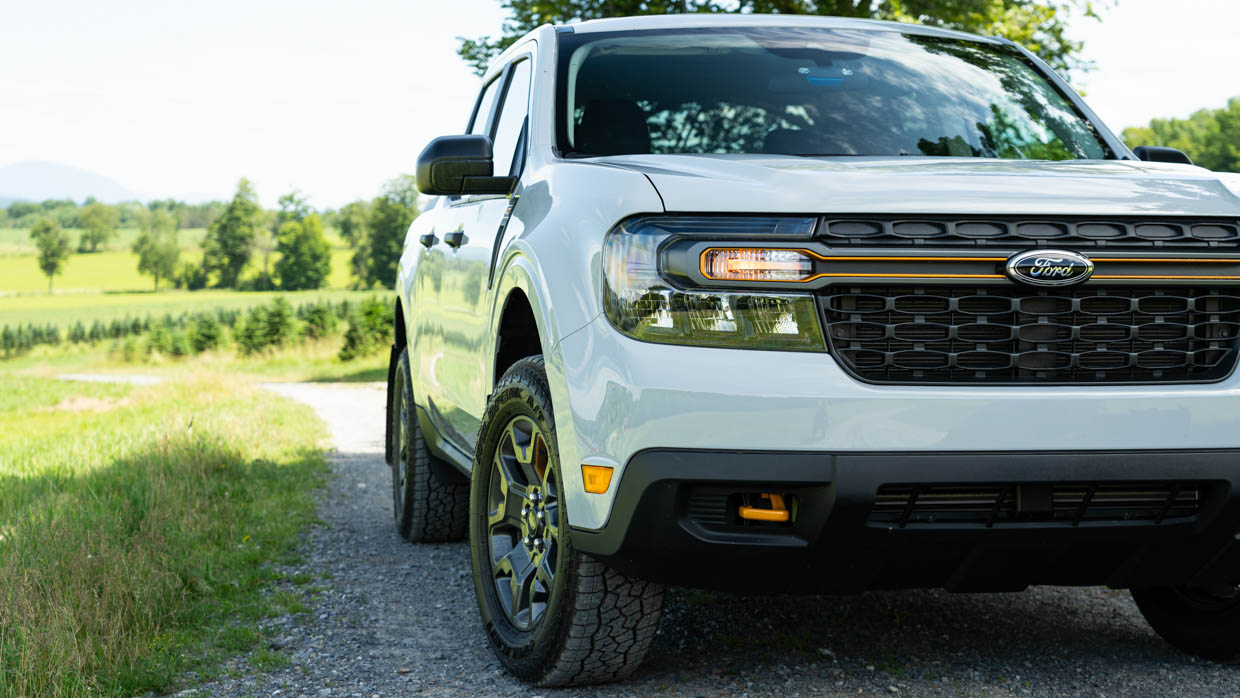
It’s a shame, because the Maverick is among a growing number of so-called ‘lifestyle’ utes, along with the Hyundai Santa Cruz, which have piqued the interest of many Australian buyers with their more SUV-like driving experience combined with the practicality of an open tray, even if it’s limited in capability in comparison to ‘proper utes’ like the Ranger.
Ford has doubled down on the strong popularity of the Ranger by diversifying its ute line-up with the full-size F-150, which will be converted locally to right-hand-drive. But with a starting price of $106,950 before on-road costs and its huge size, these won’t be suitable for many Australian buyers.
The Ranger is, also, only growing more expensive, leaving some buyers priced out of a Blue Oval-branded ute. With this in mind, is it only a matter of time before we see the Maverick in Australia?
In the US, you can get yourself into a base Maverick XL for as little as $25,595 (AUD $37,625) $29,215 (AUD $42,946), which makes it a great value to start.
For the record, that’s about $4k cheaper than a base Ford Ranger XL SuperCrew. For that you’ll get the 2.5-litre four-cylinder connected to a hybrid system, making 142kW and 362Nm and delivered only to the front wheels.
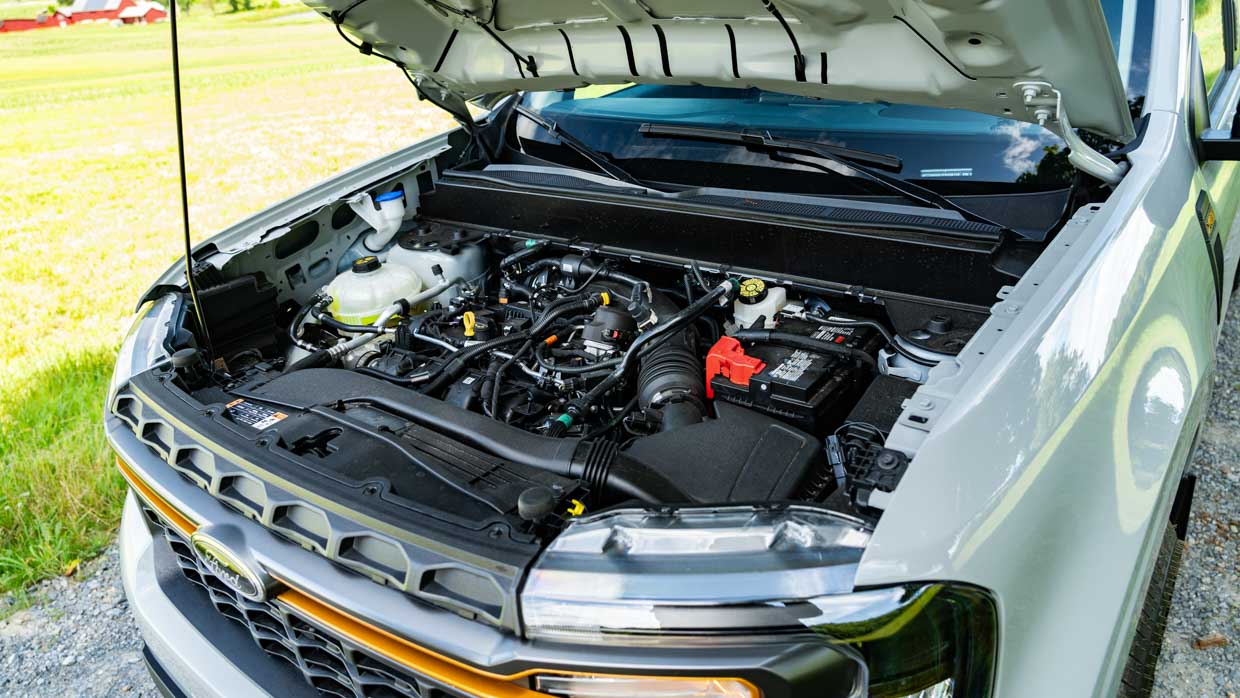
Step up to the 2.0-litre EcoBoost and power goes up considerably to 186kW, torque somewhat less to 376Nm. Here you have all-wheel-drive at your disposal and, if you like, can add on the Tremor package, with its locking rear differential, similar to what’s found on the Bronco Sport Badlands, which shares the same chassis.
The car you see pictured here is a Maverick XLT with the Tremor package, which is priced at $32,490 US, or just short of AUD $48,000.
Standard features on the base Maverick include:
The Ford Maverick shares much more with its SUV siblings the Bronco Sport and the Escape than it does with something like the Ranger or the F-150. This really is a trucked-up SUV, a ute with a bit of an identity problem, but don’t hold that against it.
That’s best seen in the driving characteristics of the Maverick, which are extremely pleasant. You don’t need to climb up into the Maverick, just take a seat and drive off.
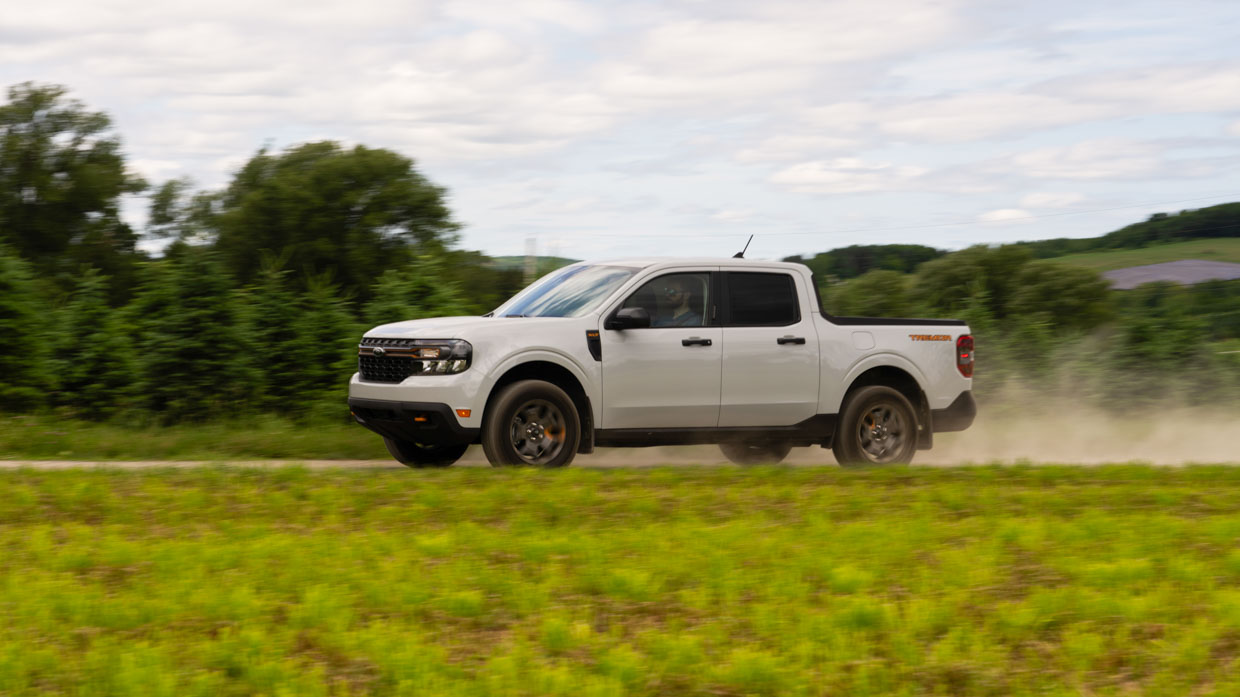
Asphalt imperfections and railway junctions are handled without drama, none of the unpleasant jostling and kicks that you’d expect from this category of vehicle.
Despite that, it’s quite capable off-road, too. While the Maverick can be had in front-wheel-drive, the Tremor’s lockable centre and rear differentials will enable you to go much farther into the rough stuff.
These are individually controlled with dedicated buttons down in the centre console, along with a third button to disable traction control. Stability control, though, sadly cannot be switched off.
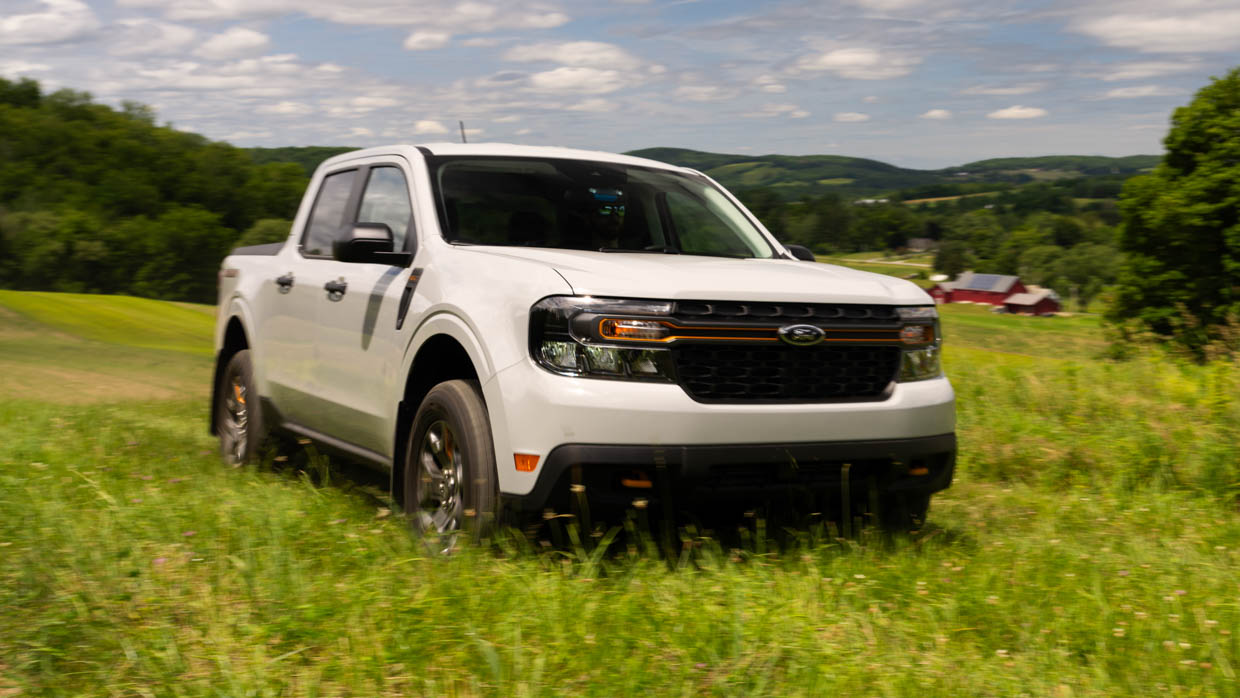
Toggle through the Tremor’s five drive modes (Normal, Sand, Mud/Ruts, Slippery, Tow/Haul) and the differentials will be optimized for your conditions, and with everything locked the Maverick is quite good on light trails.
That’s helped by the Falken Willdpeak A/T tires, which offer a good amount of off-road performance without compromising on-road livability.
The eight-speed auto slips smoothly between gears in the 2.0-litre EcoBoost guise, and it’s reasonably peppy off the line. Remarkably, that engine even sounds quite good under hard acceleration.
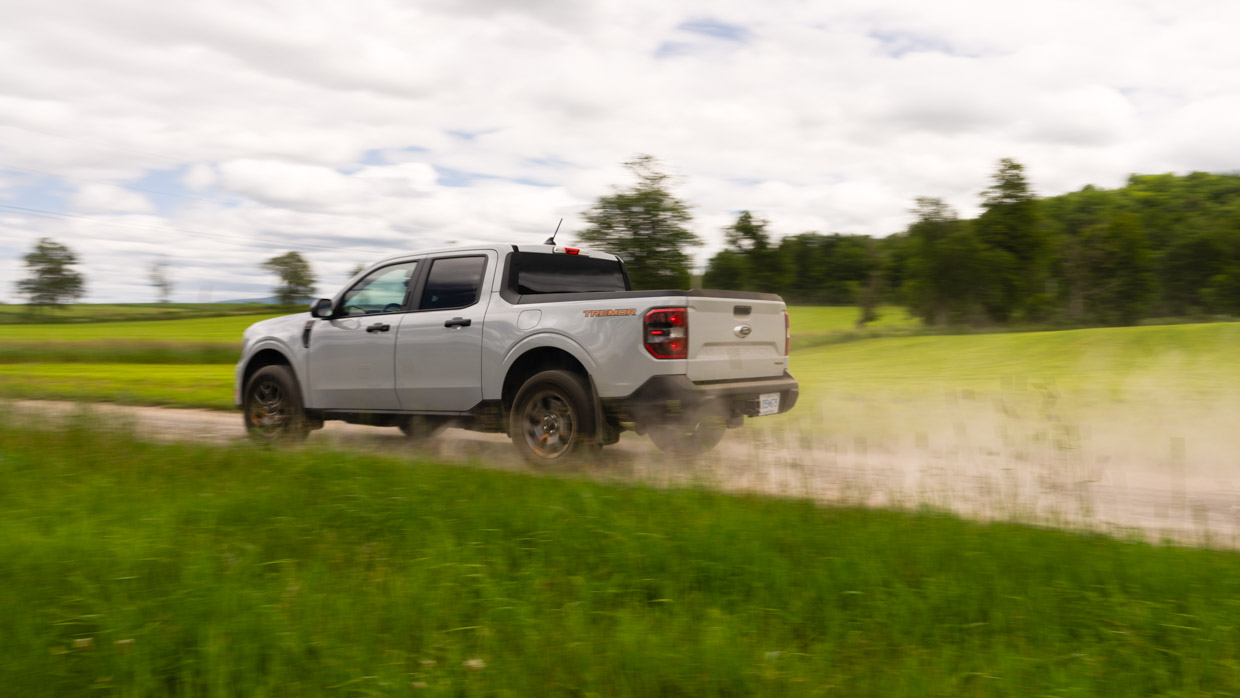
But, those looking for more frugality can opt for a strictly front-wheel-drive hybrid and its CVT, which in the US is rated for 37 mpg, or 6.4L/100km. The all-wheel-drive 2.0-litre EcoBoost, meanwhile, is rated at 25 mpg, or 9.4L/100km.
Go with the bigger motor and all-wheel drive, then add on the $745 (AUD $1095) towing hitch receiver, and the Maverick can tow a respectable 1800kg.
That’s well lower than the Ranger’s maximum 3500kg of towing, but still more than enough for a weekend’s getaway with a camper. Go with the hybrid and that rating drops down to 900kg, the payload down to 680kg from 900.
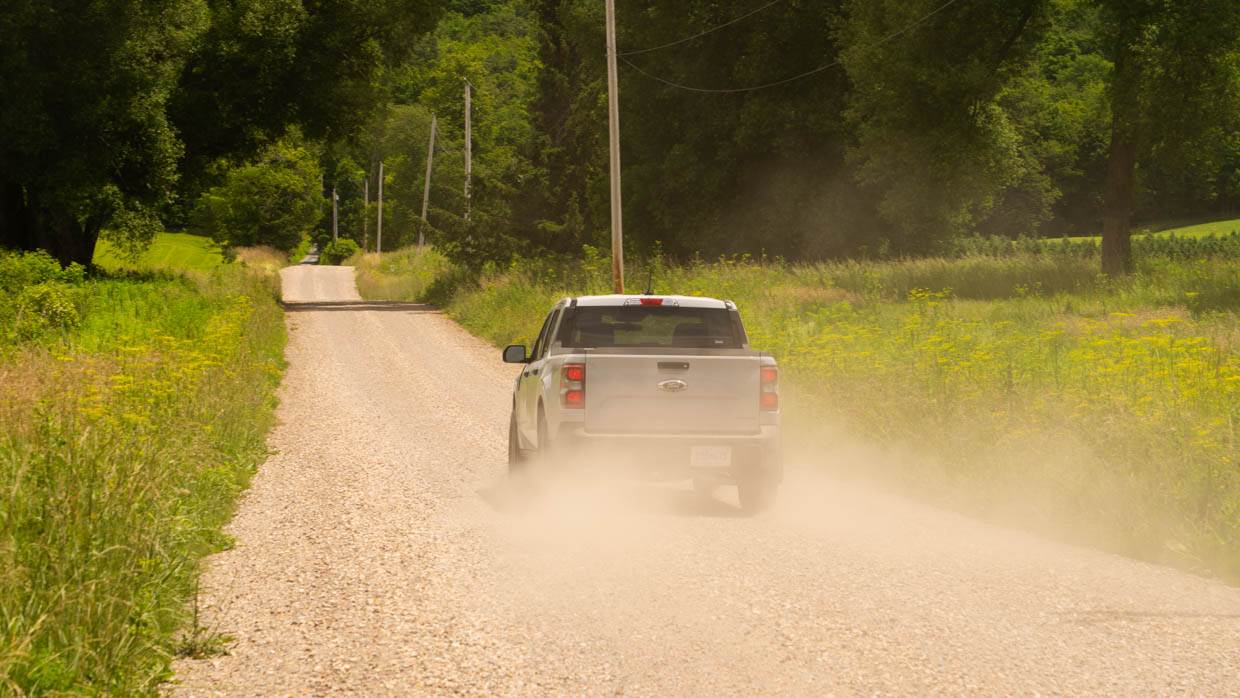
The 1.4-metre long bed lacks some of the fancier features found on the F-150 on the base truck, but click the right boxes and you can add everything from integrated lighting to power outlets and movable tie-downs.
Ford’s spray-in Toughbed liner is also available, and even the base truck features a number of integrated tie-downs both on the floor and sides. There’s even a little hidden cubby on the side that’s perfect for storing a set of tie-down straps.
Ford has given the Maverick a distinctive, spartan, and utilitarian interior that perfectly suits the character of this truck. You’ll get a first taste the second you pull the doors closed with the strange, angular door pulls. They look and feel a bit odd, and are fronted by four hex-headed screws.
Don’t like them? Remove the screws and you can design your own part. But, their stubby nature was designed to allow for tall water bottles, while the generous door cards have room for all sorts of stuff.
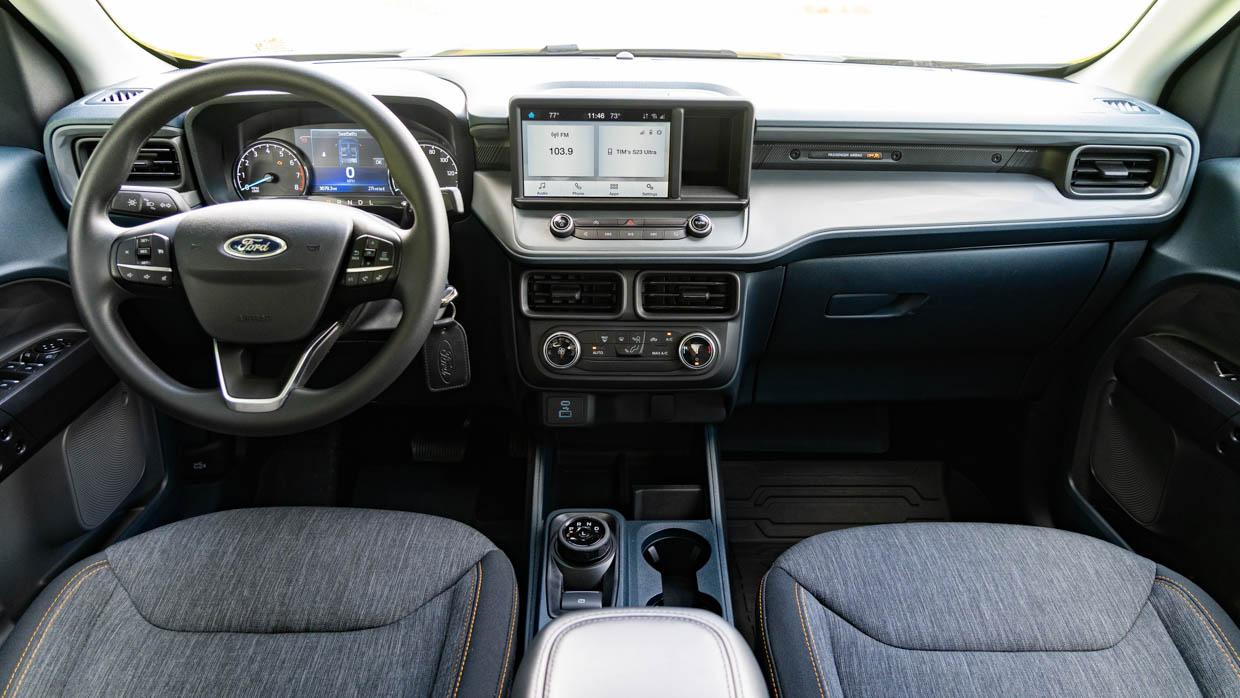
You’ll also find a number of little grooves scattered throughout the cabin. Ford calls these FITS: Ford Integrated Tether System, and the idea is that you can hang everything from cupholders to videogame consoles from them.
Ford will of course sell you a selection of components to slot in there, but if you’re handy with a 3-D printer you can design and print up your own.
Upfront seating is basic and comfortable too, with manually adjusted seats and tons of headroom. My only complaint here is that the seats feel like they’re on stilts. Even with the driver’s seat at its lowest setting the gauge cluster is more or less level with my stomach.
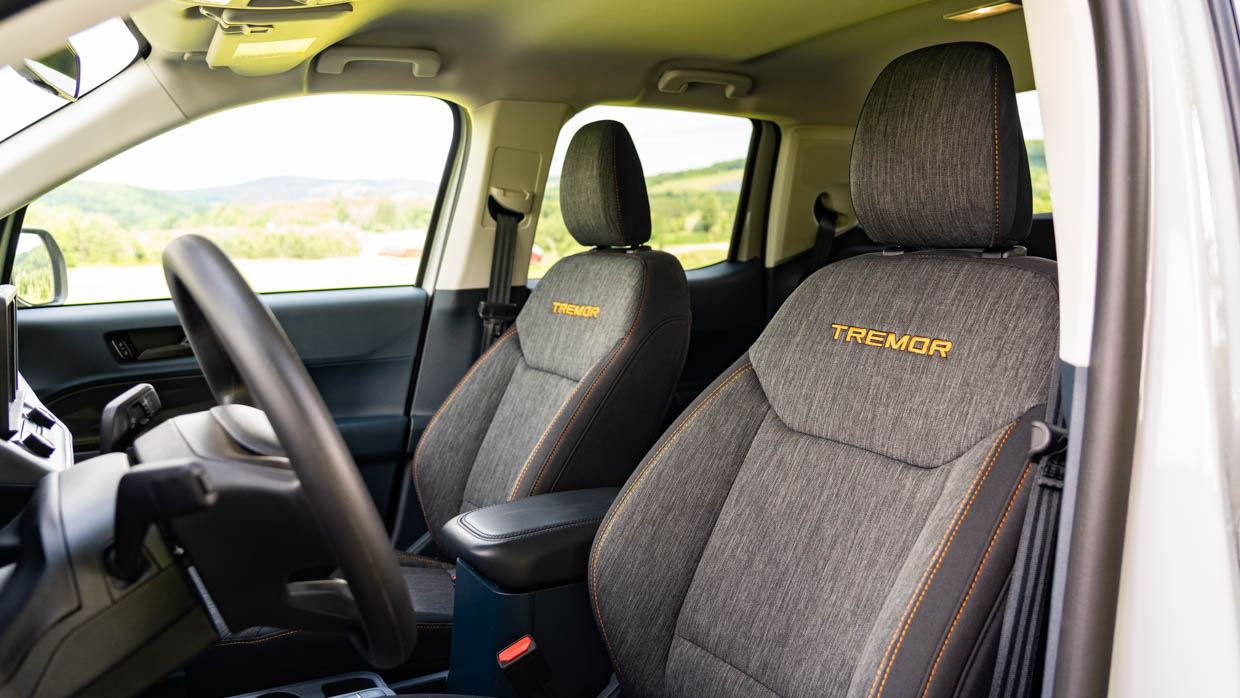
I can’t help but feel like Ford’s engineers wanted to deliver the on-high seating position of a big ute, even if the rest of the interior wasn’t scaled to match.
Beyond that, though, there’s not much to get excited about here. In the centre is an 8.0-inch infotainment system running Ford’s basic but snappy Sync 4 infotainment system, with support for both Android Auto and Apple CarPlay, though only tethered. That’s situated above a generous selection of media control buttons, including dedicated volume and tuning knobs.
Keep moving down and you’ll find physical HVAC controls, too, including an auto mode with three separate speeds.
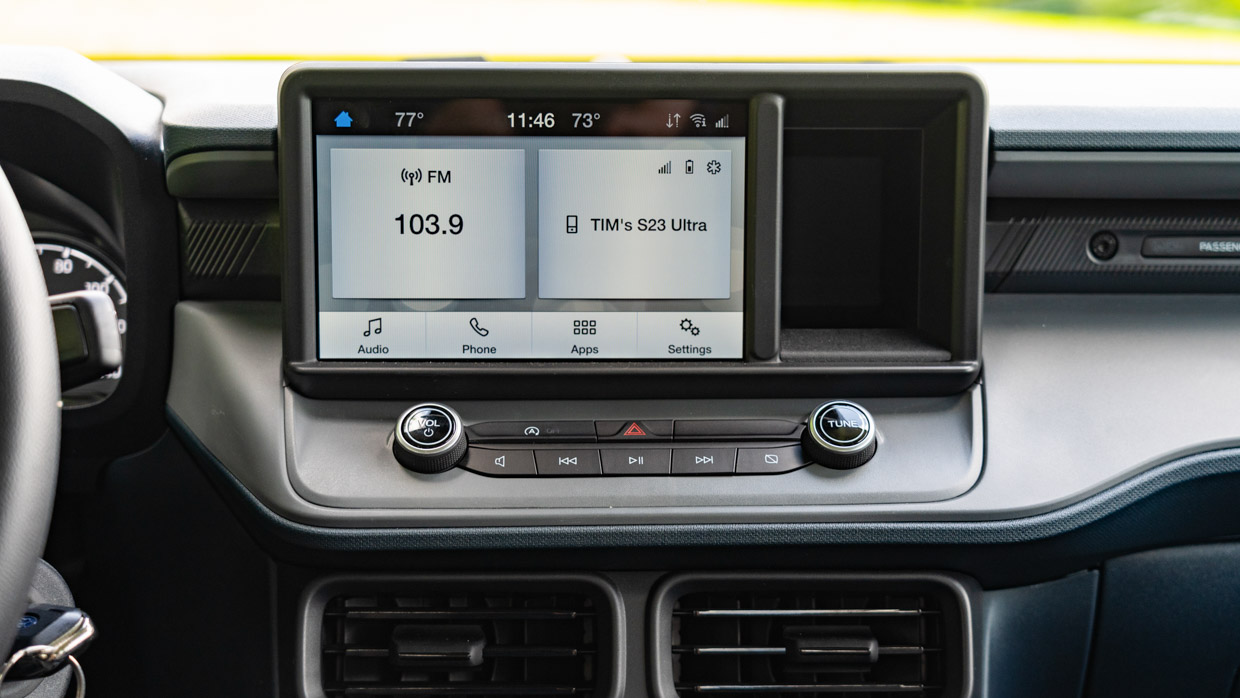
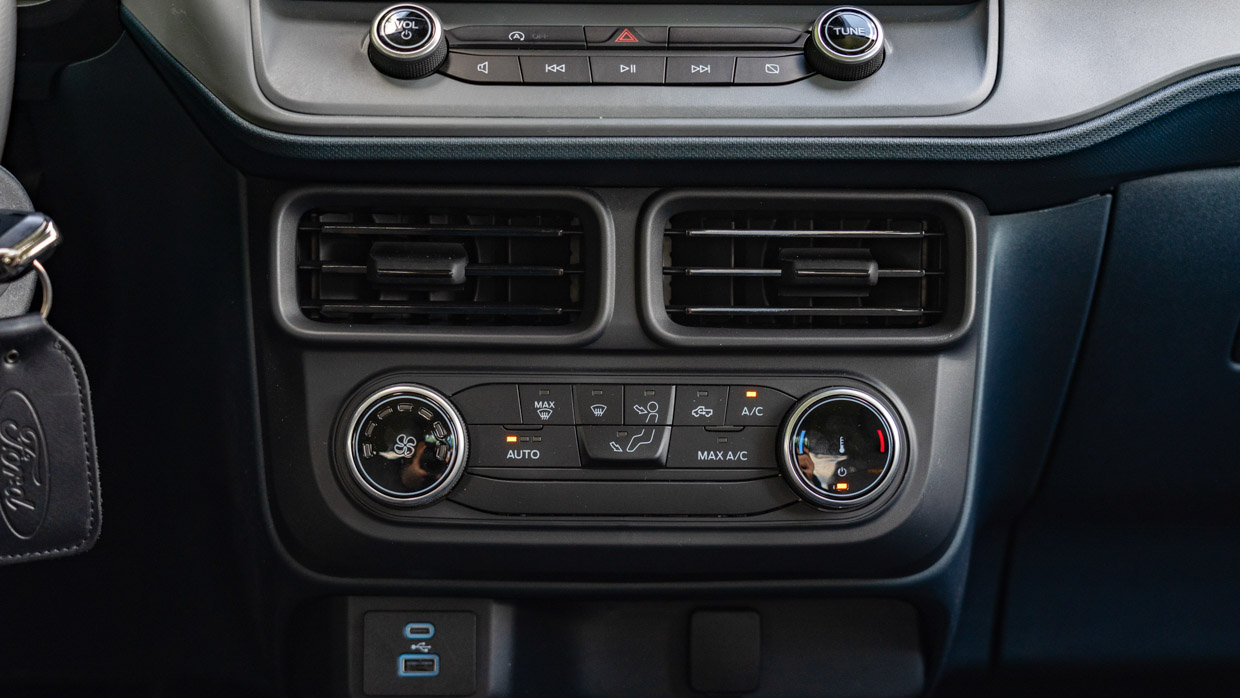
Down below that is a pair of USB ports, one A and one C. These, sadly, are the only two in the entire truck, though there are a pair of round 12-volt outlets if you don’t mind packing adapters.
All that’s built into a dashboard that is, at least in this truck, blue with grey inserts. This won’t be a colour combination for everybody, but given the overwhelmingly dark interiors we see in trucks, I think it looks great, especially in concert with the white highlights.
The gauge cluster behind the steering wheel has physical gauges for speed and RPM, with a 4.2-inch LCD in between for displaying drive modes, trip information, tire pressures, and even some light off-roading information like axial and longitudinal inclinometers.
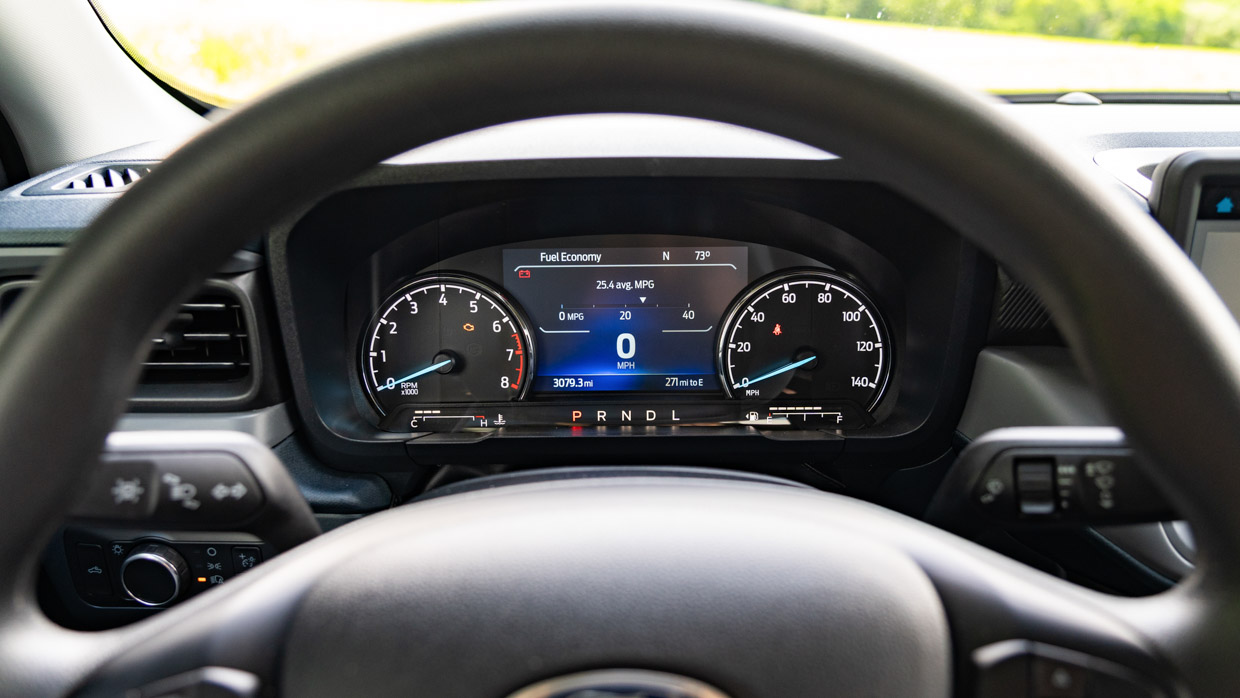
It’s here you’ll also get all the details on the Tremor’s many drive modes and differential settings as you swing through them.
There’s generous storage throughout, including a large compartment beneath the rear seats where you can lose all sorts of things.
The rear seats flip forward, too, but for seemingly no point. Regardless, keep things up right and you’ll find generous headroom and adequate legroom back there.
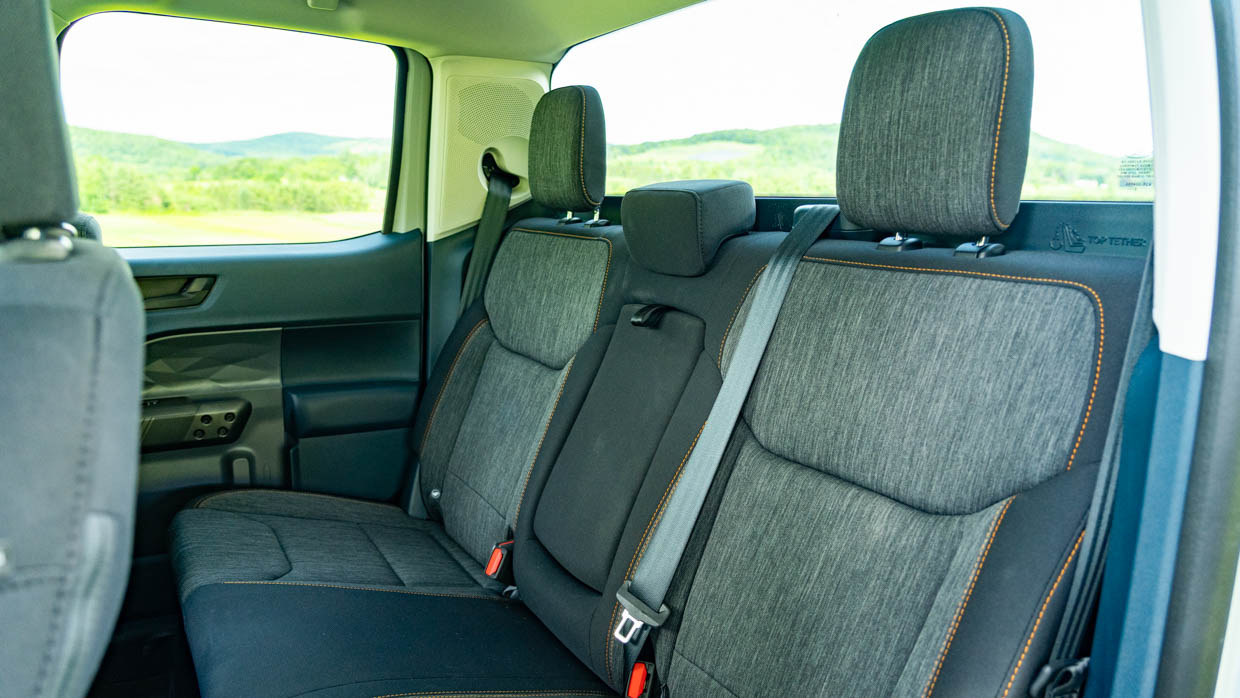
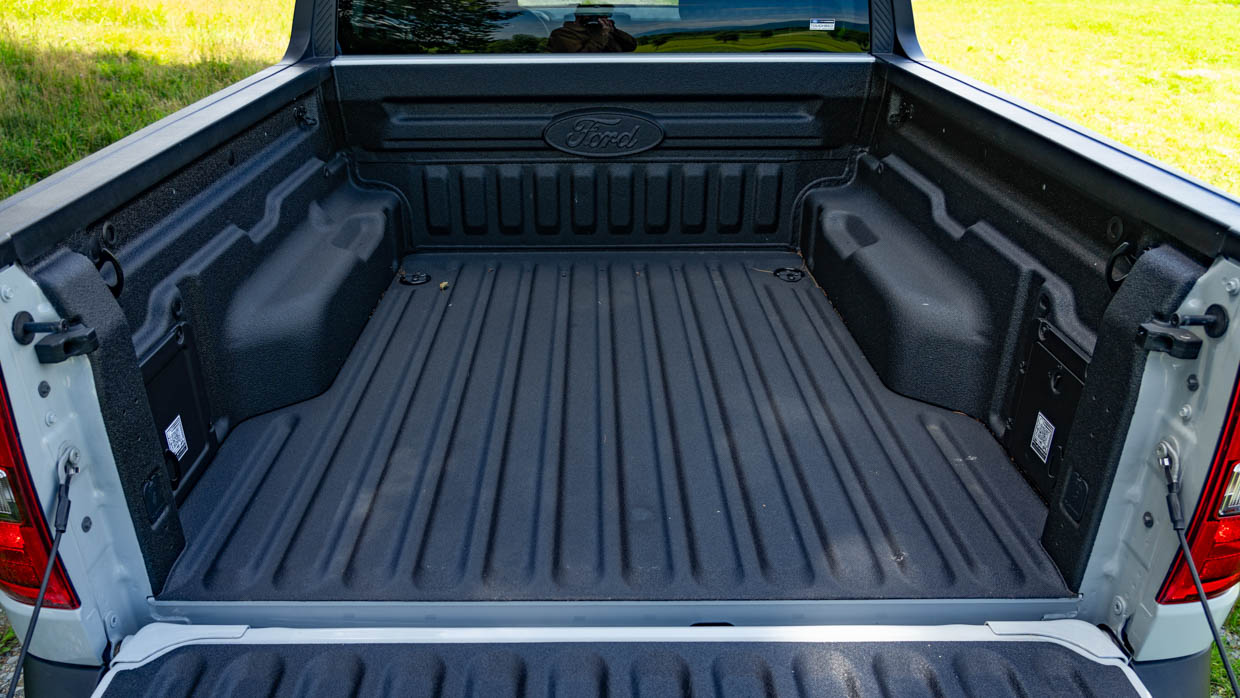
The Maverick’s tray measures 1.38m long, 1.35m wide or 1.08m between the wheel arches and 0.53m deep.
For reference, a Ranger XLT’s tray is 1.84m long, 1.58m wide or 1.2mm between wheel arches, and 0.5m deep; making the Maverick’s storage area a bit narrower and shorter but still enough to fit a few bags of compost and a few odds and ends.
While the Maverick comes standard with automatic emergency braking, Ford’s Co-Pilot 360 is a $640 option in the US, (about AUD $1000), and adaptive cruise control is only available on the top-shelf Lariat trim, which starts at $28,355 (AUD $41,682). Ford’s more advanced, hands-free Blue Cruise driver assistance system is not available on any Maverick trim.
Since the Maverick is for now only available in North America, it is not rated on any European or Australian crash test ratings but in the US, the Maverick has been tested by the US’s Insurance Institute for Highway Safety (IIHS), which upholds roughly comparable standards to ANCAP.
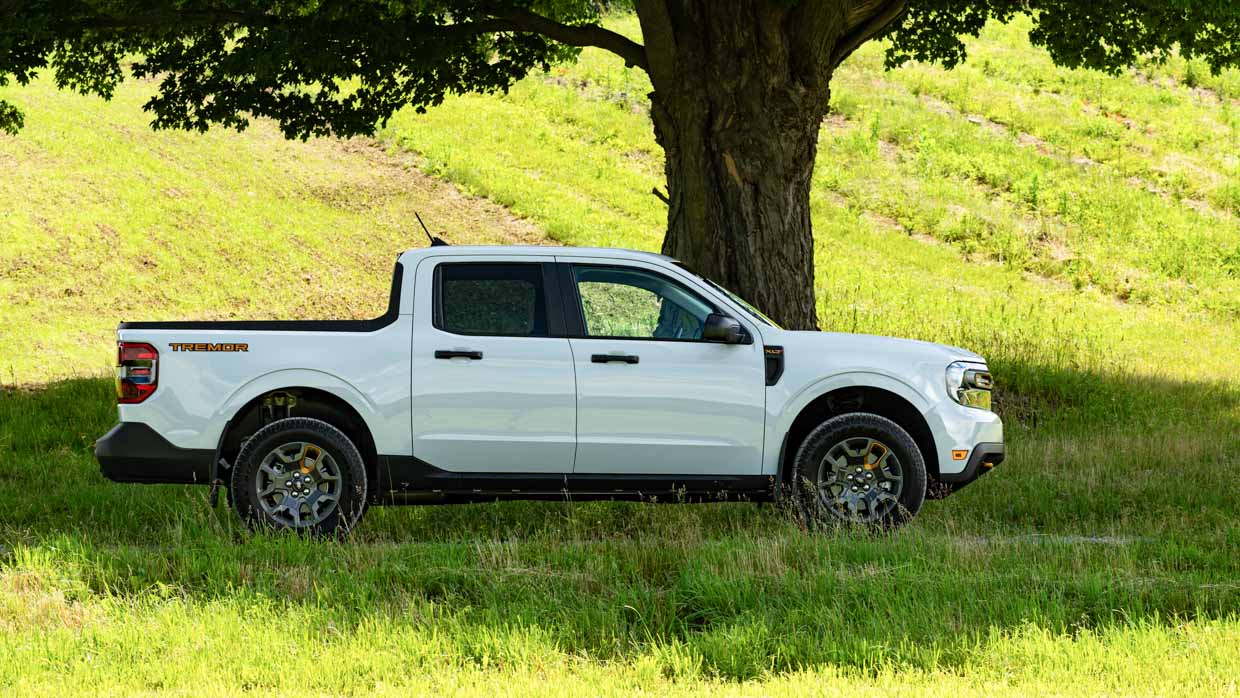
In the US, the Maverick scored a perfect five stars on the federal front and side impact crash test ratings. On the rollover test, it scored four out of five stars.
The Maverick’s crash prevention systems also scored well for avoiding collisions with another car, but its pedestrian detection systems didn’t do so well, especially at night. Likewise, its headlights scored “Acceptable,” which is one step below “Good.”
The Hybrid Maverick with the 2.5-litre EcoBoost will do 42 miles-per-gallon city, 33 highway, and 22 combined per the EPA. That works out to 5.6L/100km city, 7.0L/100km highway, and 6.4L/100km combined.
Step up to the 2.0-litre EcoBoost and those numbers rise accordingly, to 10.7L/100km city, 8.1L/100km highway, and 9.4L/100km combined. In my sporty testing, I averaged 9.3L/100km. With a 63-litre tank, that works out to a 678km maximum range.
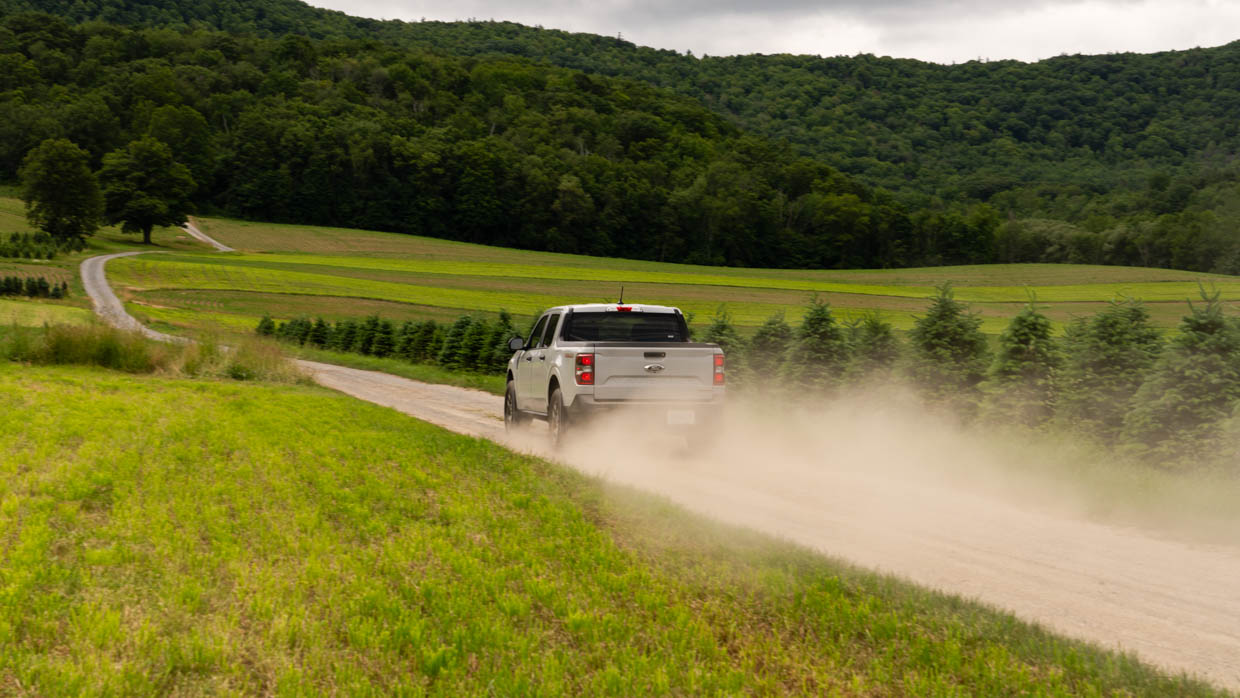
Ford has a 10,000-mile (circa-16,000km) service interval, with most intervals including simple things like oil changes, cabin air filter changes, and tire rotation, plus inspections of things like brakes and wiper blades along the way. The first significant service comes at 100,000 miles (circa-160,000km), and that just entails a set of spark plugs.
In The States, the Maverick has a comprehensive, three-year, 36,000-mile (circa-57,900km) warranty. Powertrain, meanwhile, is covered for five years, or 60,000 miles (circa-96,500km). Ford also includes free roadside assistance for that period.
The Ford Maverick, especially in Tremor trim, is a hard thing to dislike. It’s sized right, perfectly capable for most needs, and is not only a comfortable commuter but a reasonably fun toy for the weekends, too.
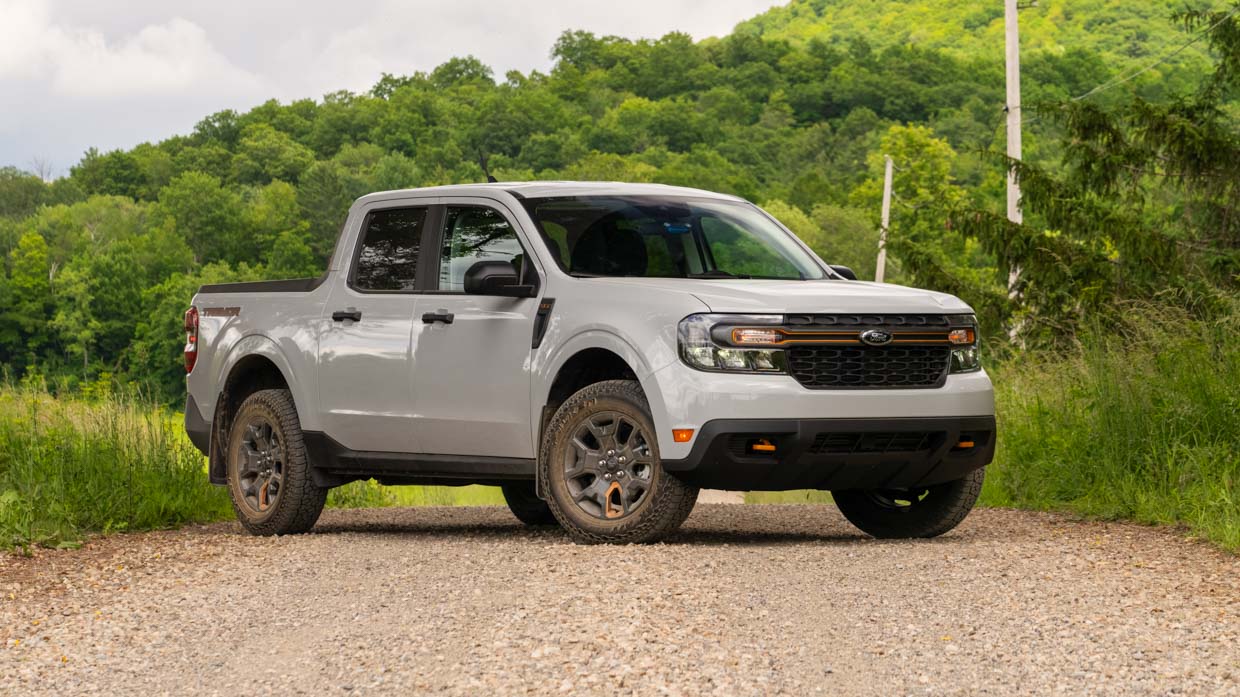
You won’t be scampering up the toughest of trails, and you might need to make an extra trip if you have a really big order at the hardware store, but in the times between you’ll also have a more frugal and liveable machine than even a Ranger or certainly an F-150.
The only question is: hybrid or all-wheel-drive?
About Chasing cars
Chasing Cars reviews are 100% independent.
Because we are powered by Budget Direct Insurance, we don’t receive advertising or sales revenue from car manufacturers.
We’re truly independent – giving you Australia’s best car reviews.
The estimate provided does not take into account your personal circumstances but is intended to give a general indication of the cost of insurance, in order to obtain a complete quote, please visit www.budgetdirect.com.au. Estimate includes 15%^ online discount.
^Conditions Apply
Budget Direct Insurance arranged by Auto & General Services Pty Ltd ACN 003 617 909(AGS) AFSL 241 411, for and on behalf of the insurer, Auto & General Insurance Company Limited(ABN 42 111 586 353, AFSL 285 571).Because we don’t know your financial needs, we can’t advise you if this insurance will suit you. You should consider your needs and the Product Disclosure Statement before making a decision to buy insurance. Terms and conditions apply.
Indicative quote based on assumptions including postcode , 40 year old male with no offences, licence suspensions or claims in the last 5 years, a NCD Rating 1 and no younger drivers listed. White car, driven up to 10,000kms a year, unfinanced, with no modifications, factory options and/or non-standard accessories, private use only and garaged at night.
^Online Discounts Terms & Conditions
1. Discounts apply to the premium paid for a new Budget Direct Gold Comprehensive Car Insurance, Third Party Property Only or Third Party Property, Fire & Theft Insurance policy initiated online on or after 29 March 2017. Discounts do not apply to optional Roadside Assistance.
2. Discounts do not apply to any renewal offer of insurance.
3. Discounts only apply to the insurance portion of the premium. Discounts are applied before government charges, taxes, levies and fees, including instalment processing fees (as applicable). The full extent of discounts may therefore be impacted.
4. We reserve the right to change the offer without notice.